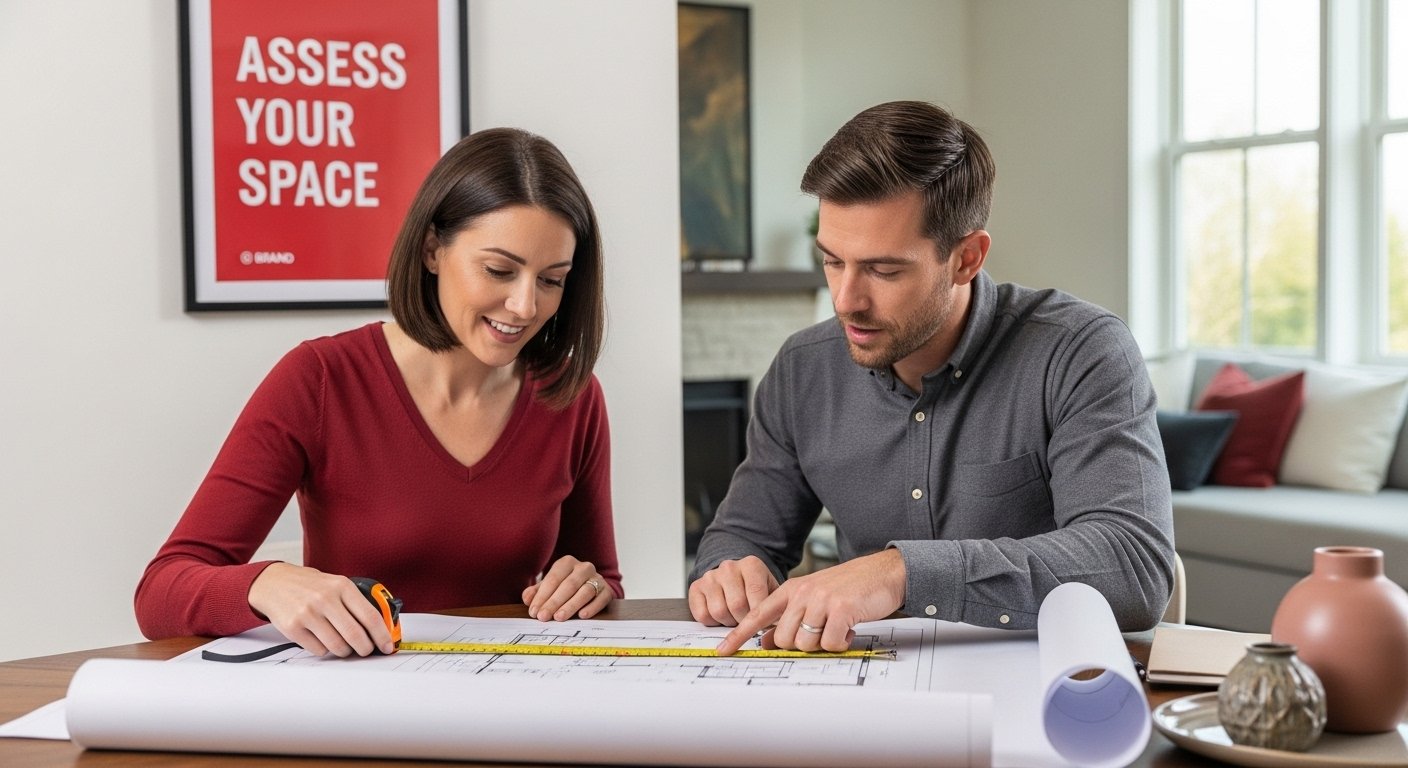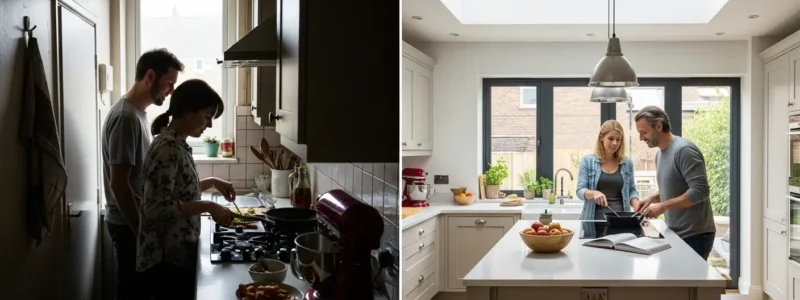Designing a bespoke home extension can feel daunting, especially when you realise nearly 30 percent of UK homeowners cite confusion about planning permissions as their top reason for delaying projects. Most people assume it is the building work that causes the stress, and yet the real challenge often starts much earlier with missteps in assessing needs, setting a brief, or securing permits. Surprisingly, getting these early stages right does more to protect your sanity, your budget, and your finished results than any hammer or blueprint down the line.
Table of Contents
- Step 1: Assess Your Current Space And Needs
- Step 2: Research Planning Permissions And Regulations
- Step 3: Create A Detailed Design Brief
- Step 4: Consult With Architects And Designers
- Step 5: Finalise Plans And Secure Necessary Permits
- Step 6: Monitor Construction And Ensure Quality Standards
Quick Summary
| Key Point | Explanation |
|---|---|
| 1. Assess your current space carefully | Evaluate your home to identify functional challenges and spaces needing improvement before planning an extension. |
| 2. Research planning permissions thoroughly | Understand local regulations and whether your project requires formal permissions to avoid legal complications. |
| 3. Create a detailed design brief | Document specific needs, measurements, and aesthetic desires to guide architects and prevent misunderstandings. |
| 4. Consult with qualified architects | Choose professionals with relevant experience to translate your vision into a feasible architectural plan effectively. |
| 5. Monitor construction quality rigorously | Regularly check construction progress and quality to ensure the extension aligns with your original plans and standards. |
Step 1: Assess Your Current Space and Needs
Designing a bespoke home extension begins with a comprehensive assessment of your current living space and understanding your specific needs. This initial phase is crucial in transforming your property into a more functional and personalised environment. Before diving into design sketches or consulting architects, you need to conduct a thorough evaluation of your existing property and lifestyle requirements.
Start by walking through your home with a critical eye, measuring rooms and identifying potential areas for expansion. Consider how your current space functions and where improvements are most needed. Are you struggling with a cramped kitchen? Do you need an additional bedroom? Perhaps you want a home office or a more open living area? Document these observations meticulously, creating a clear picture of your spatial challenges and aspirations.
Measure existing room dimensions precisely, noting ceiling heights, window placements, and structural elements like load-bearing walls. Take photographs from multiple angles to help visualise potential changes. These initial measurements will be critical when you begin discussing design possibilities with professionals. Pay special attention to your property’s orientation, natural light patterns, and how different rooms connect. Read our comprehensive guide on home extension planning to understand the nuanced considerations that can impact your project.
Consider your long-term requirements as well. A successful home extension isn’t just about immediate needs but anticipating future lifestyle changes. Are you planning to start a family? Will elderly parents potentially move in? Do you work from home and need dedicated workspace? These forward-thinking considerations will help ensure your extension remains functional and valuable for years to come. By meticulously assessing your current space and future needs, you lay a solid foundation for a truly bespoke home extension that enhances both your property’s value and your quality of life.
Below is a checklist table to help ensure you do not overlook any essential steps when planning your bespoke home extension.
| Checklist Step | Key Actions | Verification Criteria |
|---|---|---|
| Assess current space and needs | Survey home, measure rooms, note functional challenges | Measurements and notes complete; needs documented |
| Research planning permissions and regulations | Contact local authority, review guidelines, determine approval requirements | Confirmation from local authority; documented findings |
| Create a detailed design brief | Translate needs into requirements, collect inspiration, outline budget | Comprehensive brief prepared; mood board/sketches done |
| Consult with architects and designers | Review portfolios, meet candidates, discuss brief | Selected architect/designer; signed terms of engagement |
| Finalise plans and secure necessary permits | Submit complete application, respond to council requests, adjust plans if needed | Permits and approvals received; conditions understood |
| Monitor construction and ensure quality standards | Schedule site visits, document progress, review workmanship | Site logs kept; inspection sign-offs; issues addressed |

Step 2: Research Planning Permissions and Regulations
Navigating the complex landscape of planning permissions and building regulations is a critical step in your home extension journey. This phase involves understanding the legal requirements that govern home improvements and ensuring your project complies with local and national guidelines. Failing to obtain proper permissions can result in costly penalties, potential demolition orders, and significant legal complications.
Begin by contacting your local planning authority to discuss the specific regulations applicable to your property. Every local council has unique requirements that can vary based on factors like property location, conservation areas, and historical designations. Determine whether your proposed extension falls under permitted development rights or requires a full planning application. Typically, smaller extensions might be permitted without formal approval, but specific conditions must be met regarding height, width, and overall property coverage.
Carefully review the dimensional restrictions and requirements for home extensions. According to government planning guidelines, permitted development usually allows single-storey rear extensions up to 4 metres for detached houses and 3 metres for other property types. However, these limits can change, and additional considerations like neighbour consultation schemes might apply. Explore our comprehensive guide on understanding house extension approval processes to gain deeper insights into navigating these regulatory landscapes.
Beyond planning permissions, you must also consider building regulations approval. This separate process ensures your extension meets critical safety, structural, and energy efficiency standards. Engage a qualified architect or building surveyor who can help prepare the necessary documentation and drawings required for submission. They will assist in demonstrating compliance with building codes, including structural integrity, thermal performance, ventilation, and accessibility requirements. By meticulously researching and understanding these regulations, you create a solid foundation for a legally compliant and smoothly executed home extension project.
Step 3: Create a Detailed Design Brief
Crafting a comprehensive design brief is the cornerstone of transforming your home extension vision into a tangible reality. This crucial document serves as a roadmap, capturing every nuanced detail of your project and ensuring clear communication between you, architects, and contractors. A well-constructed design brief eliminates ambiguity and prevents potential misunderstandings that could derail your extension project.
Begin by translating your initial space assessment into specific, actionable requirements. Document precise functional needs, desired aesthetic elements, and practical considerations. Consider factors like natural light requirements, room flow, storage solutions, and how the new space will integrate with existing rooms. Describe the purpose of each area in the extension, whether it is a kitchen expansion, additional living space, or a home office. Include specific measurements, preferred material finishes, and any unique architectural features you want to incorporate. Learn more about our design and build planning expertise to understand how professionals approach detailed project briefs.
Photographs, sketches, and mood boards can significantly enhance your design brief by providing visual context to your written descriptions. Collect inspiration images that capture the style, colour palette, and architectural elements you envision. Include annotated floor plans showing proposed layouts, highlighting how the extension will connect with your existing property. Be explicit about budget constraints, timeline expectations, and any potential flexibility in your requirements. Address potential challenges such as structural limitations, natural light access, or specific lifestyle needs that might impact the design. By developing a meticulous and comprehensive design brief, you create a powerful tool that guides your extension project from conceptual stage to successful completion, ensuring that the final result not only meets but exceeds your expectations.
Step 4: Consult with Architects and Designers
Engaging with professional architects and designers marks a pivotal moment in transforming your home extension from conceptual vision to executable plan. This collaborative stage requires careful selection of professionals who can translate your design brief into technically feasible and aesthetically compelling architectural solutions. Choosing the right design professional can mean the difference between a mediocre extension and an extraordinary space that dramatically enhances your home’s functionality and value.
Begin your search by seeking recommendations from trusted sources and reviewing portfolios of architects specializing in residential extensions. Look for professionals with demonstrated experience in projects similar to your vision, paying close attention to their previous work’s style, complexity, and innovation. Request comprehensive portfolios that showcase their design approach, technical capabilities, and ability to navigate planning permissions. Schedule initial consultations with multiple architects, treating these meetings as strategic discussions where you can assess their understanding of your specific requirements, communication style, and creative problem-solving skills. Explore our design and build planning expertise to understand what qualities to look for in a professional design team.
During these consultations, come prepared with your detailed design brief, initial sketches, and a clear budget range. Encourage open dialogue about potential challenges, innovative design solutions, and realistic expectations. A skilled architect will not only interpret your requirements but also offer expert insights that might enhance your original concept. Discuss their proposed approach to managing planning permissions, building regulations compliance, and potential project timelines. Request detailed proposals that break down their design process, fees, and expected deliverables. Pay attention to how thoroughly they examine your property’s existing structural constraints and how creatively they propose overcoming potential limitations. By meticulously selecting and collaborating with the right architectural professionals, you set the foundation for a home extension that seamlessly blends your vision with technical expertise and regulatory requirements.
Step 5: Finalise Plans and Secure Necessary Permits
Finalising your home extension plans and securing the necessary permits represents a critical juncture in your project, transforming architectural concepts into legally sanctioned construction possibilities. This stage demands meticulous attention to detail and a strategic approach to navigating bureaucratic requirements. Precision during this phase can prevent costly delays, potential legal complications, and unexpected project setbacks.
Compile all architectural drawings, technical specifications, and supporting documentation with exceptional thoroughness. Ensure your submitted plans demonstrate comprehensive compliance with local planning regulations, building codes, and specific conservation area restrictions if applicable. Work closely with your architect to prepare a comprehensive application package that clearly illustrates the proposed extension’s design, materials, structural integrity, and alignment with neighbourhood aesthetic standards. Learn more about our comprehensive planning and permissions process to understand the intricate details involved in successful permit applications.
Submit your planning application to the local authority with patience and strategic preparation. Anticipate potential queries or requests for additional information by maintaining open communication channels with planning officers. Some councils offer pre-application consultation services, which can provide valuable insights and increase your chances of approval. Be prepared to make minor modifications to your plans if recommended, as flexibility can significantly expedite the approval process. Include detailed site plans, elevation drawings, and impact assessments that demonstrate how your extension harmoniously integrates with the existing property and surrounding environment. Monitor your application’s progress actively, responding promptly to any requests for clarification. Once you receive formal planning permission and building regulations approval, carefully review all conditions attached to the consent, ensuring you understand and can comply with every specified requirement before commencing construction.
Step 6: Monitor Construction and Ensure Quality Standards
Monitoring construction and maintaining rigorous quality standards transforms your meticulously planned extension from theoretical design into a tangible, structurally sound reality. This critical phase demands active engagement, systematic oversight, and a keen eye for detail to ensure every aspect of the construction meets or exceeds your expectations. Proactive monitoring prevents potential structural issues, budget overruns, and ensures the final result aligns precisely with your original vision.
Establish a robust communication protocol with your construction team, scheduling regular on-site meetings to review progress, discuss potential challenges, and address any emerging concerns immediately. Maintain a comprehensive project log documenting every significant milestone, material delivery, structural modification, and quality checkpoint. Request detailed photographic evidence of key construction stages, allowing you to track progress remotely and maintain a visual record of the extension’s development. Explore our expert approach to construction management to understand comprehensive monitoring strategies that safeguard your investment.
During site visits, scrutinize workmanship, material quality, and adherence to approved architectural plans with meticulous attention. Verify that structural elements, insulation, electrical work, and plumbing meet building regulation standards and align with your original design specifications. Do not hesitate to request modifications or clarifications if any aspect of the construction deviates from the agreed-upon plans. Engage independent building inspectors periodically to provide unbiased assessments of construction quality, structural integrity, and compliance with building codes. These professional evaluations offer an additional layer of quality assurance and can identify potential issues before they become costly problems. By maintaining consistent, thorough oversight throughout the construction process, you safeguard your investment and ensure the successful transformation of your home extension from concept to completion.

Turn Your Bespoke Extension Vision Into Reality with Reltic Extend
Designing a bespoke extension should not feel overwhelming. Many homeowners feel stuck at the idea stage, concerned about compliance, budget, or how to translate unique requirements into a practical and lasting design. You may be unsure where to start your journey or worried about juggling planning permission, technical hurdles and coordinating the build. This is where our expertise shines. Our team not only guides you through every detail of extension types and design inspiration, but also manages everything from your first sketches to the finishing touches. We combine over 20 years’ experience with transparent pricing, clear communication and a 10-year structural warranty, so you can relax knowing that every step is handled by specialists who truly care about your home.
Take the next step towards a tailor-made extension that perfectly fits your lifestyle, adds value to your property and avoids costly missteps. Whether you are ready to discuss your bespoke project or simply want expert advice, contact our team today and discover how our end-to-end service can turn your dream into reality. There’s no better time to secure the space and comfort your family deserves.
Frequently Asked Questions
What are the initial steps to assess my current space for a home extension?
Start by evaluating your home critically, measuring rooms, and identifying areas for improvement. Take photographs, document your observations, and consider your current needs and future requirements.
How do I determine if I need planning permission for my home extension?
Contact your local planning authority to understand the specific regulations for your property. Check whether your proposed extension falls under permitted development rights or requires a full planning application.
What should I include in my design brief for a home extension?
Your design brief should detail functional needs, aesthetic preferences, measurements, materials, and any unique features you wish to incorporate. Include photographs, sketches, and mood boards for visual context.
How can I ensure quality standards during the construction of my home extension?
Monitor the construction by maintaining regular communication with your team, documenting progress, and conducting site visits. Scrutinise workmanship and consider engaging independent inspectors for unbiased assessments.
Recommended
- Seamless Modern Extension Design | Reltic Extend
- How We Work on Extensions | Reltic Extend
- Family-Friendly Home Extensions | Reltic Extend
- Home Extensions East London | Reltic Extend
- What a Kitchen Designer Actually Does (Hint: It’s Not Just Picking Finishes)
- Guide To Building A Powerful Brand Through Web Design





